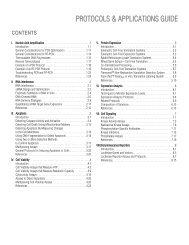2012 Promega catalogue
2012 Promega catalogue
2012 Promega catalogue
Create successful ePaper yourself
Turn your PDF publications into a flip-book with our unique Google optimized e-Paper software.
Life<br />
Science<br />
Catalog<br />
<strong>2012</strong><br />
Worldwide Contact List<br />
Section<br />
Contents<br />
Table of<br />
Contents<br />
Cell Signaling<br />
Mitochondrial Function Assay<br />
46<br />
Mitochondrial Toxicity Assay<br />
Product Size Cat.# Price ($)<br />
Mitochondrial ToxGlo Assay 10 ml G8000 286.00<br />
For Research Use Only. Not for Use in Diagnostic Procedures.<br />
100 ml G8001 1678.00<br />
Description: The Mitochondrial ToxGlo Assay is a cell-based assay method<br />
that employs sequential addition, multiplexed assay chemistry for predicting<br />
potential mitochondrial dysfunction as a result of xenobiotic exposure. The<br />
assay is based on the differential measurement of biomarkers associated<br />
with changes in cell membrane integrity and cellular ATP levels relative to<br />
vehicle-treated control cells during short exposure periods. Cell membrane<br />
integrity is first assessed by measuring the presence or abscence of a distinct<br />
protease activity associated with necrosis using a fluorogenic peptide substrate<br />
(bis-AAF-R110) to measure “dead cell protease activity”. The bis-AAF-R110<br />
Substrate cannot cross the intact membrane of live cells and therefore gives no<br />
signal with viable cells. Next, ATP is measured by adding an ATP detection reagent,<br />
resulting in cell lysis and generation of a luminescent signal proportional<br />
to the amount of ATP present. The two sets of data can be combined to produce<br />
profiles representative of mitochondrial dysfunction or non-mitochondrial<br />
related cytotoxic mechanisms.<br />
Mammalian cells generate ATP by mitochondrial (oxidative phosphorylation)<br />
and nonmitochondrial (glycolysis) methods. To achieve optimal mitochondrial<br />
responsiveness, replacing glucose-supplemented medium with galactosecontaining<br />
medium may increase cellular oxygen consumption and augment<br />
mitochondrial susceptibility to mitotoxicants.<br />
A.<br />
150<br />
ATP<br />
Cytotoxicity<br />
B.<br />
Percent Vehicle Control<br />
100<br />
50<br />
0<br />
100<br />
50<br />
0<br />
–7 –6 –5<br />
Log [imipramine], M<br />
C. D.<br />
150<br />
Percent Vehicle Control<br />
–7 –6<br />
Log [CCCP], M<br />
–5<br />
Features:<br />
• Distinguish Primary Mitochondrial Dysfunction from Secondary<br />
Cytotoxic Events: Cell-based, multiplexed method measures ATP in<br />
conjunction with a membrane integrity biomarker to distinguish primary<br />
mitochondrial dysfunction from secondary cytotoxic events.<br />
• Predictive for Mitochondrial Toxicities: Produces profiles that are consistent<br />
with mitochondrial toxicity and discernible from other nonmitotoxic<br />
mechanisms of cell death.<br />
• Easy to Implement: The assay uses a simple sequential “add-mix-read”<br />
format to assess toxicity in the sample well.<br />
• Fast: Quickly assess potential mitochondrial liabilities in under an hour.<br />
• Cost-Effective: Assays are performed directly in cell culture plates using<br />
standard multimode detection instrumentation.<br />
• Flexible and Easily Automated: The volume of reagent addition can be<br />
scaled to meet throughput needs; the assay is amenable to automation in<br />
96- and 384-well plates.<br />
Storage Conditions: Store the Mitochondrial Tox-Glo Assay components<br />
at –20°C.<br />
Protocol Part#<br />
Mitochondrial ToxGlo Assay Technical Manual TM357<br />
Percent Vehicle Control<br />
Percent Vehicle Control<br />
250<br />
200<br />
150<br />
100<br />
50<br />
0<br />
600<br />
500<br />
400<br />
300<br />
200<br />
100<br />
–6 –5<br />
Log [digitonin], g/L<br />
–4<br />
0<br />
–7 –6 –5 –4<br />
Log [antimycin], g/L<br />
Representative profiles of mitochondrial toxicity with the Mitochondrial ToxGlo Assay. K562 cells were plated at 10,000 cells/well in 96-well<br />
plates and treated with serial dilutions of compounds resuspended in glucose-free (galactose-supplemented) RPMI 1640 medium for 2 hours.<br />
Panel A shows no changes in ATP or membrane integrity (MI), which indicates that the compound is not a mitochondrial toxin. Panel B. The reduction in ATP<br />
with commensurate MI changes indicate that the compound is not a mitochondrial toxin; instead primary necrosis is taking place. Panel C. The reduction in<br />
ATP with no changes in MI indicates that the compound is a mitochondrial toxin. Panel D. The reduction in ATP with discordant changes in MI indicate that the<br />
compound is a mitochondrial toxin.<br />
For complete and up-to-date product information visit: www.promega.com/catalog<br />
9955MA
















